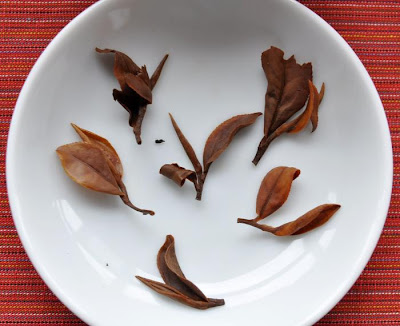1. Left - Taiwan No 19, Bi Yu (blue - jade)
This cultivar was obtained in 2004 by crossing qingxin oolong with jinxuan oolong. It is recommended to make Baozhong tea. This makes sense, since all these samples were obtained from the Wenshan area (famous for its Baozhongs).
Appearance: The leaves are greenish and with fur.
The smell is intoxicating, but it also has a tofu lu smell, which feels heavy and disturbing.
2. Right - Taiwan No 13, Tsui Yu (emerald - jade)
This cultivar was obtained in 1981, at the same time as the jinxuan. It's also a more floral cultivar that can be processed into Baozhong, Oolong or even red tea. (I currently have one from Yi Guang Shan in my selection.)
Appearance: long and red dry leaves. Little fur.
The dry scents have the intoxicating scent I like and no defects.
The brew of the Bi Yu is darker. Both have a good clarity (or turbidity if you want to use a more technical word).
 |
| Bi Yu vs Tsui Yu |
Still, it beats the Bi Yu and shows why Tsui Yu is quite a popular cultivar nowadays.
For the decoration, I'm having some fun using the small vases made by my children (in Yingge, with the help of a potter). This is what happens when Sponge Bob character Plankton inspires pottery! Kids love to play with clay and they are happy to see their works on my Cha Xi.
After 2 modern cultivars, let's taste 2 lesser known, local leaves:
3. Left - Tao Ren.
The leaves are dark, long and thin. We see few white buds. The dry smell is fruity with a hint of chocolate and quite pleasant.
The brew has a light orange color and a good clarity.
The scents are complex and ripe. But they lack elegance and finesse.
4. Right - Man zhong
The dry colors are closer to a '5 colors tea', the synonym of Oriental Beauty. The many tips are very furry and large.
The dry smell feels too 'green'. The oxidation seems to have stopped too early.
The brew is darker and has a good clarity as well.
 |
| Tao Ren vs Man zhong |
 |
| Tao Ren |
 |
| Man zhong |
This tasting didn't reveal a flawless Oriental Beauty. It shows, again, how varied Oriental Beauty can be from one cultivar to another. Tasting average Oriental Beauties could be a disappointment. What makes this interesting is the fact that we know the cultivar of each sample.
 | ||
| qinghua jar to store Oriental Beauty |
















3 comments:
I am thoroughly enjoy this discussion of Oriental Beauty and learning so much here. Thanks! I had thought Oriental Beauty would be just one cultivar, but it is not.
Si it's still miss Bailu the winner from there ;)?
Can't wait the next part, you are very lucky to have such a diversity available for one single kind of tea . It should be a very pleasant elsson to take.
Dear Stéphane,
Again an excellent article. I was wondering if some teafarmers also have different cultivars on 1 plantation?(not necessarily OB but just normal rolled oolong). It would be a nice idea to catologue particular characteristics of each cultivar as they do as example with apples (sour/sweet, crunchy/soft etc...)
Post a Comment